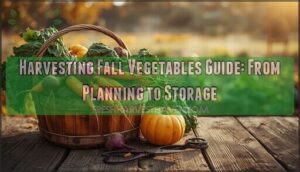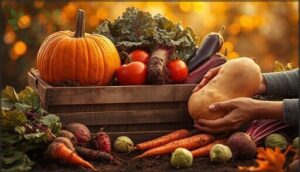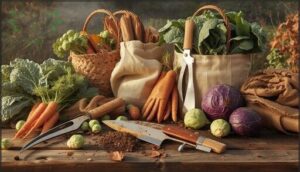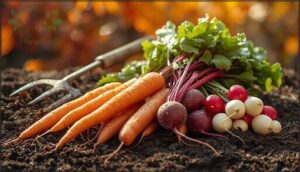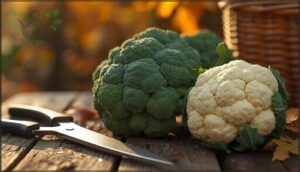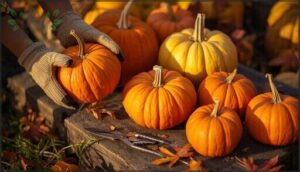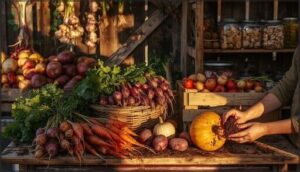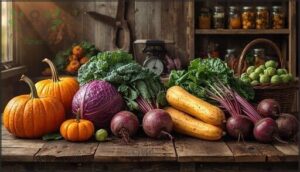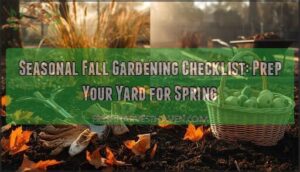This site is supported by our readers. We may earn a commission, at no cost to you, if you purchase through links.
The difference between a bland carrot and a sweet, crisp one often comes down to a single decision: when you pull it from the ground. Fall vegetables develop their best flavor when harvested at just the right moment, but knowing that moment takes more than guesswork. Temperature shifts, visual cues, and even the time of day you harvest can transform your crop from forgettable to exceptional.
This harvesting fall vegetables guide walks you through each step—from choosing crops that match your climate to storing your bounty so it lasts through winter. You’ll learn to read the signals your vegetables send when they’re ready, use the right tools to avoid damage, and apply simple techniques that preserve both flavor and freshness for months.
Table Of Contents
- Key Takeaways
- Planning Your Fall Vegetable Harvest
- Recognizing Peak Ripeness in Fall Vegetables
- Essential Harvesting Tools and Techniques
- Step-by-Step Guide to Harvesting Popular Vegetables
- Post-Harvest Handling and Storage Tips
- Maximizing Flavor and Preserving Your Harvest
- Frequently Asked Questions (FAQs)
- Is your vegetable garden ready to harvest in the fall?
- How do I choose the best fall harvest vegetables?
- Can you plant vegetables in the summer for fall harvest?
- What are some good crops for fall harvest?
- When should fall harvest crops be planted?
- When is the best time to harvest vegetables?
- When to harvest fall vegetables?
- When to clean up a vegetable garden in fall?
- Should you till your vegetable garden in the fall?
- When should I clean my vegetable garden in the fall?
- Conclusion
Key Takeaways
- Harvest timing matters more than you think—fall vegetables develop peak sweetness and flavor when you pick them after light frosts and during cooler temperatures, which trigger natural sugar production in crops like carrots, kale, and Brussels sprouts.
- Work backward from your first frost date and add 10-60% extra days to maturity calculations since shorter daylength and cooler fall temperatures slow growth significantly compared to spring and summer planting.
- Each vegetable sends clear ripeness signals you can read—roots resist thumbnail pressure when mature, brassica heads stay tight before harvest, squash rinds harden enough to resist puncture, and proper color develops fully before peak flavor arrives.
- Post-harvest handling determines how long your vegetables last—cure winter squash and roots in specific temperature ranges, store different crops in separate zones based on their humidity and temperature needs, and check stored produce weekly to catch spoilage early.
Planning Your Fall Vegetable Harvest
A successful fall harvest starts long before you step into the garden with your basket. The choices you make in late summer—what to plant, when to plant it, and how to time your sowings—directly shape what you’ll be pulling from the soil come October and November.
Let’s walk through the key decisions that set you up for a bountiful fall harvest.
Selecting Suitable Fall Crops
Fall crop selection starts with matching cool-weather vegetables to your climate and garden conditions. Kale, broccoli, and carrots thrive in cooler temperatures, while lettuce and spinach handle light frosts well.
Choose varieties based on your space, soil type, and pest resistance needs. Fast-maturing cultivars work best when growing seasons are short, ensuring you harvest before hard freezes arrive.
Fall is a great time to grow cool season crops that thrive in colder weather.
Understanding Days to Maturity
Knowing the maturity definition—days from planting to first harvest—helps you plan smart. Temperature impact and shorter daylength slow growth in fall, so add 10-60% more days depending on planting dates. Radishes mature in 25 days normally but may need 50 near frost.
Climate adjustments matter: crop maturity varies by vegetable, affecting harvest timing and understanding vegetable ripeness through clear harvest signs. To accurately plan, gardeners should consider frost dates.
Timing Planting for Local Frost Dates
Once you understand maturity dates, you’ll need to work backward from your first frost date to find the right planting time. Frost date averages mark when temperatures usually hit 32°F in your area, but microclimate variations can shift this by a week or more.
Use a frost dates calculator with your zip code to get local data. Add the fall factor—about 14 days—since cooler weather slows growth. Account for frost tolerance too: tender crops need extra buffer time before frost arrives.
Succession Planting Strategies
Beyond timing single plantings, succession planting techniques let you extend your fall harvest window for weeks. Staggered planting every 7 to 14 days keeps lettuce, radishes, and arugula coming through October. This continuous harvest approach optimizes space while preventing overwhelm at harvest time.
Here’s your succession planting roadmap for harvesting fall vegetables:
- Plant fast growers like arugula every two weeks for steady salad greens
- Rotate crops in the same bed after early harvests finish
- Choose early and late varieties together to spread harvest timing naturally
- Dedicate one bed purely to succession crops for easier fall garden planning
- Interplant quick crops between slower ones to get the most out of space optimization and shelf life
Recognizing Peak Ripeness in Fall Vegetables
Knowing when your fall vegetables are ready to pick makes all the difference between bland and flavorful produce. Each crop sends out its own signals when it’s at peak ripeness, and understanding these signs helps you harvest at just the right moment.
Let’s look at what to watch for so you can bring in vegetables at their absolute best.
Visual and Physical Ripeness Indicators
Your vegetables speak clearly when they’re ready to harvest. You just need to know what to look for. Here are the key signs of crop maturity:
| Indicator | What to Check |
|---|---|
| Color indicators | Butternut squash turns solid tan; watermelon undersides shift from greenish-white to cream |
| Texture signals | Squash skin resists fingernail pressure; root vegetables feel heavy and firm |
| Shape indicators | Snap beans reach near-maximum pod size before toughening |
| Stem condition | Dry, brown squash stems signal readiness; onion tops fall over |
Master these ripeness signals and your harvesting techniques improve instantly.
Impact of Daylength and Temperature
As fall arrives, photoperiodism effects and temperature thresholds shape your harvest dramatically. When daylength drops below 10 hours, most vegetables slow their growth interaction considerably. Here’s how cooler temperatures and daylength impacts growth affect your cold weather vegetables:
- Frost exposure sweetens Brussels sprouts and kale through physiological adaptations
- Shorter days extend crop scheduling by slowing metabolic rates
- Impact of weather on flavor intensifies as nights lengthen
This timing directly influences harvesting fall vegetables successfully.
Vegetable-Specific Harvest Signs
When harvesting vegetables, look for root firmness by pressing your thumbnail against carrots or beets—mature ones resist indentation. Leaf color tells you when kale reaches 4-6 inches with dark green hues. Brassica heads like broccoli need tight buds before yellowing appears.
Squash rind should resist fingernail puncture, while cucumber length of 6-10 inches signals crop maturity. These harvesting techniques guarantee proper timing for root vegetables and leaf vegetables alike.
Essential Harvesting Tools and Techniques
How you harvest your fall vegetables matters just as much as when you harvest them. The right tools and techniques protect your crops from damage and help them store longer.
Let’s walk through the essentials that’ll make your harvest smoother and keep your vegetables in top shape.
Choosing The Right Harvesting Tools
The right tools make your harvest easier and protect your crop. Sharp bypass pruners or Felco snips cut cleanly through stems without crushing tissue. For squash, use heavy-duty knives to slice thick stems. Prioritize blade sharpness and tool ergonomics to reduce fatigue.
Garden forks loosen soil around roots like carrots and beets without damage.
Budget-friendly options work well with proper maintenance.
Best Practices for Gentle Handling
Gentle handling starts the moment you touch your crop. Your harvesting techniques directly impact shelf life and flavor, so slow down and handle each vegetable as if it bruises easily—because it does.
- Cut, don’t pull. Use sharp harvesting tools to avoid tearing stems and damaging root systems.
- Support from below. Cradle vegetables during transfer to reduce bruising and impact damage.
- Keep things dry. Harvest after morning dew dries to prevent mold and disease spread.
Post-harvest handling and post-harvest care begin in the garden, not the kitchen.
Harvesting in Optimal Weather Conditions
Weather plays a starring role in harvest timing and produce quality. Dry conditions are non-negotiable—wet vegetables invite disease and poor storage outcomes. Aim to harvest during cooler morning hours after dew evaporates to retain crispness and reduce water loss.
Crop-specific needs matter. Brassicas tolerate light frost and gain flavor from it, while squash and pumpkins demand bone-dry conditions to prevent decay. Temperature fluctuations during harvest impact respiration rates—cooler conditions slow respiration and preserve freshness longer. Post-harvest weather affects storage success, so avoid harvesting mistakes by checking forecasts and planning around rainfall or temperature spikes.
| Weather Factor | Impact on Harvest |
|---|---|
| Temperature | 55°F–75°F ideal for cool-season crops; warm-season crops prefer 65°F–95°F |
| Moisture | Wet conditions increase disease risk and reduce shelf life; always harvest dry |
| Frost | Light frosts improve sweetness in brassicas and roots; hard freezes cause damage |
| Time of Day | Early morning after dew dries preserves texture and flavor |
| Humidity | Higher humidity reduces post-harvest moisture loss during harvest |
Methods for Leafy Greens, Roots, and Squash
Once conditions align, your harvest techniques determine success. Leafy greens thrive with the cut-again method—snip leaves an inch above soil, encouraging regrowth harvest cycles over weeks.
Root harvest timing matters: loosen soil with a fork, pull gently, and handle root hairs carefully to prevent decay.
For squash, always use shears for a clean squash stem cut, leaving one inch attached. These harvesting techniques protect your crop’s flavor and storage potential.
Step-by-Step Guide to Harvesting Popular Vegetables
Each fall vegetable has its own harvest method that brings out the best flavor and keeps it fresh longer. Knowing the right technique for roots, greens, brassicas, and squash makes all the difference in your garden’s yield.
Let’s walk through how to harvest each type so you get the most from your fall garden.
Harvesting Root Vegetables (Carrots, Beets, Radishes)
When harvesting root vegetables like carrots, beets, and radishes, timing and technique matter. Radishes mature quickly in 3-4 weeks, while carrots need 8-12 weeks. Check crop diameter—carrots should reach ½-1 inch and beets 1.5-3 inches. A light frost impact actually sweetens roots.
- Make sure soil pH stays between 6.0-6.8 for healthy growth
- Use harvesting tools like digging forks to loosen compacted soil
- Pull roots steadily to avoid breaking them
- Follow proper storage practices by trimming tops to ¼ inch
Harvesting Leafy Greens (Kale, Spinach, Lettuce)
Leafy greens like kale, spinach, and lettuce follow different harvest timing than roots. Kale matures in 50-55 days when leaves reach hand size. Spinach and lettuce are ready at 4-6 inches after 4-6 weeks.
Use the cut-and-come-again method—snip outer leaves with sharp pruners, taking no more than one-third per harvest. Morning picking ensures crisp leaves. Post-harvest cooling to 32°F preserves leaf quality. You’ll see 1-2 harvests weekly with proper yield frequency.
Harvesting Brassicas (Broccoli, Cauliflower)
Broccoli and cauliflower need different harvesting techniques than leafy greens. Broccoli harvest timing is key—cut heads when they’re tight, firm, and green at 8 inches from the stem. Cauliflower curd firmness signals readiness when heads feel compact and dense.
Use sharp pruners at the best cutting height to prevent head damage. Harvest in dry conditions, then cool both brassicas quickly to 32°F for best post-harvest quality.
Harvesting Squash and Pumpkins
When you’re ready to harvest squash and pumpkins, look for bright color and a hard rind that resists your fingernail. These signs mark squash ripeness and proper harvesting fall vegetables timing.
- Cut stems with sharp shears, leaving 2-4 inches attached for better storage conditions
- Handle like a ball, not by the stem, during harvesting methods
- Cure at 80-85°F for 5-10 days (skip acorn squash)
- Store at 50-55°F in dry areas for the curing process benefits
- Harvest before frost impact damages your crop’s post-harvest handling quality
Post-Harvest Handling and Storage Tips
Your harvest doesn’t end when you pull vegetables from the ground. How you handle and store them afterward makes all the difference in keeping that garden-fresh flavor for weeks or even months.
Let’s walk through the key steps to clean, cure, store, and monitor your fall vegetables so nothing goes to waste.
Cleaning and Prepping Vegetables
Proper cleaning and prepping of vegetables after harvesting fall vegetables makes all the difference for safe, long-lasting food preservation. Start with soil removal—mechanical brushing eliminates up to 85% of debris from root crops without washing. For microbial reduction, vinegar washes cut surface contamination by over 90%, far outperforming plain water quality checks alone.
| Cleaning Step | Key Benefit |
|---|---|
| Trimming techniques (remove tops, damaged leaves) | Extends storage life by 35% |
| Vinegar or sanitizer wash | Reduces microbes 70–90% |
| Air-dry 20–30 minutes | Cuts decay risk by 50% |
| Use sanitized containers | Prevents pathogen transfer by 90% |
Always trim damaged tissue before washing—it lowers fungal infections by 30%. After preparing vegetables for storage, air-dry them thoroughly using proper drying methods to prevent mold. These post-harvest handling steps protect your hard work and keep your harvest fresh longer.
Curing Techniques for Long-Term Storage
When you cure vegetables properly, you extend their shelf life by weeks or even months. Here’s how to cure your fall harvest for long-term storage:
- Root vegetables: Cure carrots, beets, and potatoes in cool, dark, well-ventilated spaces at 59-68°F for 1-2 weeks to toughen skins and seal minor injuries.
- Bulb curing: Dry onions and garlic for 1-2 weeks at 80-90°F with good airflow until necks are completely dry.
- Winter squash and sweet potatoes: Cure squash at 80-85°F for 7-14 days; sweet potatoes need 10 days at 85°F, then up to 6 weeks at 55-60°F to develop sweetness.
Curing conditions vary by crop, but proper postharvest handling techniques reduce spoilage by 50% or more. Skip washing before curing—dirt acts as a natural barrier.
These storage tips for managing vegetable storage turn your fall vegetable storage from weeks into months of fresh eating.
Ideal Storage Conditions by Vegetable Type
Each vegetable thrives under different storage conditions, so think of your fall vegetable storage space like a root cellar with different zones. Root vegetables need cold (32-40°F) with 90-95% humidity control and good ventilation needs.
Leafy greens prefer similar temperatures but watch ethylene sensitivity—keep them away from apples.
Winter squash stores warmer at 50-60°F with lower humidity, maximizing shelf life for months with proper temperature impacts and storage duration management.
Monitoring and Managing Stored Produce
You need to check your stored harvest at least once a week to catch spoilage identification early—soft spots or mold spread fast. Use a thermometer for temperature control and monitor humidity levels with simple gauges.
Keep ethylene management in mind by separating squash from apples. These storage conditions in your root cellar prevent microbial growth, maximizing shelf life through careful postharvest handling.
Maximizing Flavor and Preserving Your Harvest
The real reward of fall gardening comes when you taste the difference that good soil and perfect timing can make.
Once you’ve harvested your vegetables, you’ll want to preserve that fresh flavor for months to come. Let’s explore how to get the best taste from your garden and keep it going long after harvest season ends.
Enhancing Flavor Through Soil and Timing
Think of your soil as a flavor factory. Soil composition rich in organic matter boosts sweetness in carrots and beets, while balanced nutrient management prevents diluted taste.
Rich soil acts as a flavor factory, boosting sweetness in root vegetables through organic matter and balanced nutrients
Harvest timing matters too—cooler temperatures and shorter daylength trigger sugar production in fall vegetables. Temperature effects and soil health work together, enhancing vegetable sweetness when you harvest after light frost.
Your timing makes all the difference.
Classic Fall Vegetable Recipes
Your harvest shines brightest when you transform it into delicious meals. Root vegetable roasts with carrots and beets bring natural sweetness to the table, while squash-based soups and butternut squash chili warm you from within.
Try braised brassicas like Brussels sprouts with maple bacon, or fall harvest salads mixing kale with roasted acorn squash.
Sweet potato dishes and creative options like pumpkin butter showcase your garden’s best flavors.
Fermenting, Freezing, and Canning Options
Beyond fresh cooking, you can preserve your bounty through three proven methods. Fermentation benefits your gut with probiotics, while freezing techniques lock in nutrients—frozen broccoli keeps 90% of its vitamin C for a year. Canning safety requires proper equipment and temperatures, especially for low-acid vegetables.
Each preservation comparison shows different nutrient retention and shelf life advantages for preserving fall harvest.
Extending Shelf Life and Enjoyment
Proper storage conditions paired with curing techniques make your fall vegetables last months longer. You’re already preserving through freezing techniques and canning methods—now extend what stays fresh. Follow these packaging methods:
- Wrap winter squash individually after curing at 80-85°F for ten days
- Store root crops at 32-40°F with 90% humidity
- Conduct regular inspection weekly, removing any decay
Smart flavor preservation means enjoying your garden well into winter.
Frequently Asked Questions (FAQs)
Is your vegetable garden ready to harvest in the fall?
Your garden shows harvest readiness when roots peek above soil and broccoli buds stay tight.
Crop inspection reveals maturity—determining vegetable maturity means checking frost preparation timing against your local climate before harvesting fall vegetables begins.
How do I choose the best fall harvest vegetables?
While most gardeners chase summer abundance, the real treasure lies in fall’s quiet harvest.
Choose cold-hardy varieties like kale and carrots that match your space constraints, soil preparation efforts, pest resistance needs, and family preferences for maximum success.
Can you plant vegetables in the summer for fall harvest?
Yes, you can plant vegetables in summer for fall harvest. Focus on cool-season crops like broccoli, kale, and lettuce planted mid to late summer, plus fast-maturing varieties for succession sowing before frost.
What are some good crops for fall harvest?
Cool-weather vegetables like kale, broccoli, carrots, and lettuce thrive when temperatures drop. These cold-hardy fall crop varieties tolerate light frosts, and many fast-growing options mature quickly before the first hard freeze arrives.
When should fall harvest crops be planted?
Planting fall vegetables happens between mid-July and mid-September, depending on your frost date timing and crop maturity days.
Calculate backward from your first expected frost, using succession planting dates to extend your harvest window throughout autumn.
When is the best time to harvest vegetables?
The best time to harvest vegetables is when they reach peak ripeness, indicated by proper size, color, and firmness.
Days to maturity, frost dates, and vegetable-specific signals guide best timing for maximum flavor.
When to harvest fall vegetables?
Think of your fall harvest as a well-timed dance with nature. Harvest when vegetables show ripeness indicators—like full color and firmness—while watching frost timing and maturity days to capture peak flavor before temperatures drop.
When to clean up a vegetable garden in fall?
You should clean up your vegetable garden after the first hard frost, usually between October and November.
This timing helps with pest prevention, reduces disease carryover, and allows proper soil preparation for spring.
Should you till your vegetable garden in the fall?
You can till your fall vegetable garden, but weigh tilling benefits like pest reduction against tilling drawbacks such as soil erosion and disrupted soil health.
Alternatives like composting, crop rotation, and cover crops often improve nutrient-rich soil better.
When should I clean my vegetable garden in the fall?
Start your fall garden cleanup after the first frost, once frost-hardy vegetables finish harvesting. This timing aids disease prevention, pest control, and soil preparation.
Regional variations may shift schedules slightly.
Conclusion
A gardener in Vermont once left her carrots in the ground through the first frost, unsure if she’d waited too long. She pulled one up and tasted the sweetest carrot she’d ever grown. That frost had triggered the magic.
This harvesting fall vegetables guide gives you the same confidence—to read your garden’s signals, harvest at the peak moment, and fill your kitchen with vegetables that taste like autumn itself.
- https://store.almanac.com/pages/most-popular-club?utm_campaign=OFAEdit&utm_content=fallgarden
- https://extension.unh.edu/blog/2020/08/fall-vegetable-gardening
- https://gardenplanner.almanac.com/
- https://warren.cce.cornell.edu/gardening-landscape/warren-county-master-gardener-articles/fall-planting-for-the-vegetable-garden
- https://draxe.com/nutrition/fall-vegetables/

